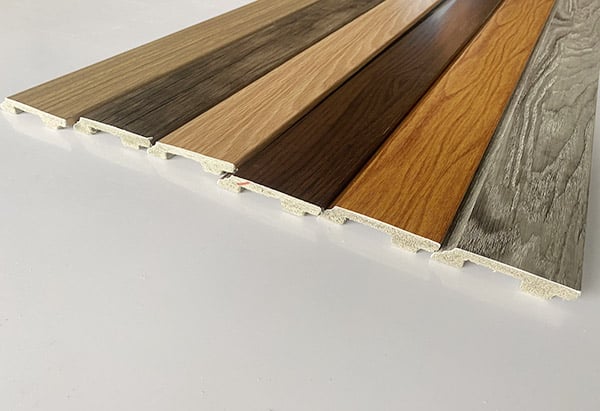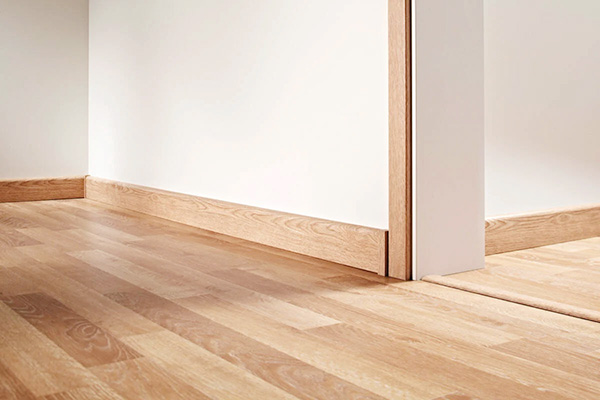1. What is baseboard?
Baseboards are also known as baseboards or skirting boards. They are used to decorate, protect, cover gaps, and ensure stability at the base of the wall. Furthermore, baseboards help to effectively enhance the aesthetics of the space, beautifying every corner of your home.

Baseboard moldings are also known as baseboard moldings or baseboard skirting.
There are many types of baseboards for you to choose from. These include laminate industrial wood baseboards, natural wood baseboards and plastic baseboards. These are also the 3 most commonly used types of baseboards.
2. Application of baseboards
Baseboards are an important material when installing laminate flooring. The effect of baseboards helps reduce the roughness and monotony of the baseboard corners. Helps you create more highlights for the interior space.
The following are the applications that baseboards bring. This is also the reason why this material is increasingly chosen by many projects for interior construction:
- Brings aesthetics, helps to hide defects and gaps between walls and floors: When choosing to use baseboards, it will definitely bring you an extremely aesthetic space. Not only that, baseboards also help to highlight the interior space, luxurious and outstanding.
- Environmentally friendly and safe: Baseboards are made of completely harmless materials, safe for health. Baseboards also do not pollute the environment because they can be recycled if not used.
- Wall protection: Because the baseboard has extremely good anti-mold, anti-termite and anti-warping properties. After installation, you will no longer have to worry about yellowing or moldy walls.
- Cost savings: Baseboards are rarely damaged. Not only that, they also have a very long lifespan. You will not need to spend a lot of money on replacement or repair costs. Just invest once, you can use it for a long time.
- Easy to install: Many people are afraid of installing interior items because they are afraid of being difficult to install and time-consuming. However, baseboards are very light and easy to install in many areas.

Application of baseboards in construction and installation.
Baseboards with many outstanding applications can bring you a satisfactory space. Therefore, you can be completely assured if you intend to use this baseboard.
3. Popular types of baseboards
3.1. Natural wood baseboard
Baseboards made from natural wood are being favored and chosen by many families. This type of baseboard is made from solid sawn wood and finished with PU paint. Below are the advantages and disadvantages of this type of baseboard:
- Advantages: Highly aesthetic, sharp and sturdy design, outstanding feature is environmental friendliness.
- Limitations: In humid environments, this type of molding will easily warp and be infested with termites. Besides, it will also cost much higher than industrial wood.
Therefore, when constructing natural wood baseboards, there will be ways to limit this disadvantage. The baseboard will be covered with an additional layer of scratch resistance and treated against warping, shrinkage and termites like the floorboards. You can be completely assured about the health of your family members.
3.2. Industrial wood baseboard
This type of molding will be made from industrial plywood. The outer layer is covered with a layer of wood grain, so the price will be cheaper than the above type of molding. Besides, industrial wood molding has many colors and diverse wood grain.
3.3. Ceramic tile baseboard
Ceramic tile skirting is a material that is highly appreciated for its durability and low cost. This type has many diverse forms and is mass produced. However, the luxury and aesthetics are not high because ceramic tile skirting has discontinuous and non-standard joints.
3.4. Artificial stone baseboards
Moldings made from artificial stone have high durability. Guaranteed never to be damaged by termites, warped or shrunk. In addition, this type of molding is also very easy to clean and wipe. The only downside is the high price.
3.5. Plastic skirting
Plastic skirting boards are currently the most popular. Because the baseboard is made of plastic, it is highly water-resistant, moisture-proof, termite-proof, and especially cheap. The surface of the skirting board is covered with a glossy wood grain layer, beautiful and easy to construct.
3.6. Alloy baseboard
Alloy skirting is produced from metal alloys such as aluminum or steel, plated. With a variety of colors such as white, black, stainless steel, shiny gold, champagne gold... Moreover, this type of skirting has good corrosion resistance, is often highly durable, and easy to maintain.
Metal or alloy baseboards can replace wooden or plastic baseboards. Here are the advantages and disadvantages of this type of baseboard:
- Advantages: Fireproof, hard to shrink or warp. Relatively durable and eye-catching colors suitable for all design styles.
- Disadvantages: Quite difficult to construct, so it requires highly skilled workers. The price of alloy baseboards is quite high. Therefore, it is only used in high-end interior designs or areas with high humidity.
4. Should I use baseboards?
Baseboards are accessories that you choose to use or not. Usually, baseboards are used for newly built projects, medium or large areas, without baseboards.
If the baseboard is low and recessed into the wall, you can install the baseboard outside the baseboard. Whether or not to use baseboard depends on the homeowner's preference and design.
Here are 2 suggestions to help you choose the right baseboard color:
- Choose the color of the baseboard to match the floor color or main wall color.
- Choose a baseboard color that contrasts with the floor or wall color but still matches the wall or floor color.
Baseboards can be applied in all interior spaces from living room, bedroom, kitchen, bathroom,... Or in commercial areas such as: schools, kindergartens, hospitals, offices, hotels, restaurants, cafes, gyms, fashion shops...




































































































Comment (0)